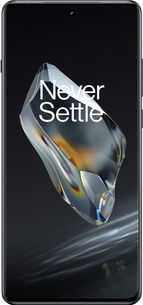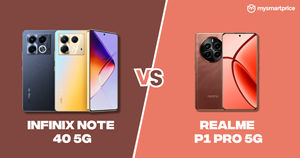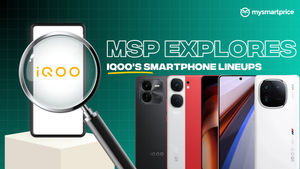
Selecting a flagship smartphone within the Rs 80,000 price range can be challenging, given the number of options in the market. Fortunately, at MySmartPrice, we’ve done the research for you. When choosing a smartphone, factors like the processor, battery life, display quality, and overall design are critical. In this buying guide, we will review all the key details of the smartphones we’ve chosen for you, all within the Rs 80,000 price segment. Let’s get started.
Top Flagship Phones Under Rs 80,000: Side-By-Side Comparison
Here’s a side-by-side comparison of the four flagship smartphones using our mini-comparison widget. We will provide a detailed explanation of each phone’s key features.
|
4.5 ★
|
4.5 ★
|
4.5 ★
|
4.6 ★
| |
|
₹ 69,998
|
₹ 57,790
|
₹ 52,999
|
₹ 63,999
| |
| Processor | Snapdragon 8 Gen 3 | Snapdragon 8 Gen 3 | Snapdragon 8 Gen 3 | MediaTek Dimensity 9300 |
| Display | 6.36″ (16.15 cm) 120Hz Display | 6.82″ (17.32 cm) 120Hz Display | 6.78″ (17.22 cm) 144Hz Display | 6.78″ (17.22 cm) 120Hz Display |
| Rear Camera | 50+50+50 MP Rear | 50+48+64 MP Rear | 50+50+64 MP Rear | 50+50+64 MP Rear |
| Front Camera | 32 MP Front | 32 MP Front | 16 MP Front | 32 MP Front |
| RAM & Storage | 12 GB RAM 512 GB Storage | 12 GB RAM 256 GB Storage | 12 GB RAM 256 GB Storage | 12 GB RAM 256 GB Storage |
| Battery | 4610 mAh 90W Charging | 5400 mAh 100W Charging | 5000 mAh 120W Charging | 5000 mAh 120W Charging |
| OS | Android v14 | Android v14 | Android v14 | Android v14 |
Xiaomi 14: Focus on the Cameras
The Xiaomi 14 features a 6.36-inch OLED display with a 120Hz refresh rate. This ensures a smooth scrolling experience and effortless app opening and closing animations. With a peak brightness of 3000 nits, the display remains perfectly visible even under direct sunlight. The display quality is excellent, offering high-quality videos with accurate colours.
We reviewed the Jade Green colourway, which has a glossy back panel. This darker colour tends to attract fingerprints, making the phone look untidy. The glossy finish can also make the phone a bit slippery. Nonetheless, the design is stunning, and the phone is comfortable for one-handed use.
Powered by the Qualcomm Snapdragon 8 Gen 3 SoC, the Xiaomi 14 delivers a great multitasking experience. It handles casual games like Subway Surfers and Clash of Clans very well. However, it tends to get warm with more demanding games like BGMI and Call of Duty: Mobile, becoming uncomfortably hot after extended sessions.
-
 View Photos (18)Xiaomi 14₹69,998 Buy on Amazon4.5 ★Expert Score: 8.5/10Snapdragon 8 Gen 3 Octa core6.36″ (16.15 cm) 120Hz LTPO AMOLED50+50+50 MP Rear Camera32 MP Front Camera12 GB RAM | 512 GB StorageCompare See specifications
View Photos (18)Xiaomi 14₹69,998 Buy on Amazon4.5 ★Expert Score: 8.5/10Snapdragon 8 Gen 3 Octa core6.36″ (16.15 cm) 120Hz LTPO AMOLED50+50+50 MP Rear Camera32 MP Front Camera12 GB RAM | 512 GB StorageCompare See specifications
The camera setup includes a 50MP main Leica camera, a 50MP telephoto camera, and a 50MP ultra-wide camera. The primary camera performs well in various conditions, producing rich, detailed images. The telephoto and ultra-wide cameras also offer good quality. However, the Xiaomi 14 occasionally struggles with light streaks in low-light conditions. The front-facing 32MP camera takes good selfies with moderately visible skin smoothing.
The phone has a 4610mAh battery and a 90W fast charger, allowing it to charge from 0% to 100% in 36 minutes. In the PCMark battery test, Xiaomi 14 lasted 14 hours and 2 minutes, which is impressive. For light to moderate users, this translates to a 24-hour battery life. The Xiaomi 14 runs on HyperOS, based on Android 14. Although the phone comes with many pre-installed apps, they are removable. Overall, the software experience is smooth.
Considering all these factors, the Xiaomi 14 is a compact phone with an excellent multitasking experience, great cameras, and impressive battery life. However, avid gamers might consider other options.
OnePlus 12: An All-Rounder
Like the Xiaomi 14, the OnePlus 12 is powered by the Qualcomm Snapdragon 8 Gen 3 SoC. It handles any task you throw at it with ease. Everyday activities such as calling, texting, taking photos, scrolling through Instagram, and casual browsing work smoothly.
Heavy games like BGMI and Call of Duty: Mobile run on the highest settings with a consistent 90fps frame rate. The phone’s cooling system further enhances the gaming experience, ensuring extended gaming sessions are a breeze, which is great for frequent gamers.
The OnePlus 12 features a 6.82-inch ProXDR display with a 120Hz refresh rate. With a peak brightness of 4500 nits, around 1500 nits more than the Xiaomi 14, the display remains bright in any lighting condition, indoors or outdoors. The display quality is excellent, making it ideal for streaming content.
-
 View Photos (25)OnePlus 12₹64,999 Buy on Amazon4.5 ★Expert Score: 8.7/10Snapdragon 8 Gen 3 Octa core6.82″ (17.32 cm) 120Hz AMOLED50+48+64 MP Rear Camera32 MP Front Camera12 GB RAM | 256 GB StorageCompare See specifications
View Photos (25)OnePlus 12₹64,999 Buy on Amazon4.5 ★Expert Score: 8.7/10Snapdragon 8 Gen 3 Octa core6.82″ (17.32 cm) 120Hz AMOLED50+48+64 MP Rear Camera32 MP Front Camera12 GB RAM | 256 GB StorageCompare See specifications While we do not consider OnePlus devices a flagship killer anymore - considering they are priced in the premium territo...Read Full Review
While we do not consider OnePlus devices a flagship killer anymore - considering they are priced in the premium territo...Read Full Review
In terms of design, the OnePlus 12 has a flowy texture that might not appeal to everyone. The curved finish makes it comfortable to hold, though the phone is somewhat heavy, which might be an issue during prolonged use.
The device has a 50MP primary camera with OIS, a 64MP periscope camera, and a 48MP ultra-wide camera. The OnePlus 12 captures impressive photos with vibrant colours and minimal noise. It also features a 32MP selfie camera, which takes natural-looking selfies.
Running on OxygenOS 14, based on Android 14, the phone offers extensive customisation options. The stock Android experience enhances the overall user experience.
The OnePlus 12 has a 5400mAh battery and a 100W SUPERVOOC charger. In our charging test, the phone fully charged in 38 minutes, just two minutes more than the Xiaomi 14. While running the PCMark battery test, the phone encountered errors due to the 20 per cent battery notification, which lasted approximately 14 hours before reaching the 20 per cent mark. The OnePlus 12 can last a full day, even with heavy use, which is expected at this price point. Hence, if you’re looking for an all-rounder phone, the OnePlus 12 is an excellent choice.
iQOO 12: A Gaming Phone That Ticks All The Boxes…
The iQOO 12’s design language is extraordinarily stunning. The glossy back finish does not attract fingerprints but is very slippery. If you’re prone to accidental drops, using a case is advisable.
This phone features a 6.78-inch LTPO AMOLED display with a 144Hz refresh rate. With a peak brightness of 3000 nits, reading under glaring sunlight is not difficult on the iQOO 12. The excellent display quality ensures a high-quality content streaming experience with rich and detailed colours.
Powered by the Qualcomm Snapdragon 8 Gen 3 SoC, the iQOO 12 handles everyday tasks effortlessly. High-end gaming titles like BGMI and Call of Duty: Mobile run smoothly on the highest settings, and the 144Hz refresh rate enhances the gaming experience. While the phone does get warm after extended use, the Vapor Chamber Cooling system effectively manages the heat.
-
 View Photos (25)iQOO 12 5G₹52,9994.5 ★Expert Score: 8.5/10Snapdragon 8 Gen 3 Octa core6.78″ (17.22 cm) 144Hz AMOLED50+50+64 MP Rear Camera16 MP Front Camera12 GB RAM | 256 GB StorageCompare See specificationsOut of Stock
View Photos (25)iQOO 12 5G₹52,9994.5 ★Expert Score: 8.5/10Snapdragon 8 Gen 3 Octa core6.78″ (17.22 cm) 144Hz AMOLED50+50+64 MP Rear Camera16 MP Front Camera12 GB RAM | 256 GB StorageCompare See specificationsOut of Stock The iQOO 12 shines with Snapdragon 8 Gen 3, excelling in performance and gaming. Improved cameras and design. It leads in...Read Full Review
The iQOO 12 shines with Snapdragon 8 Gen 3, excelling in performance and gaming. Improved cameras and design. It leads in...Read Full Review
Running on Funtouch OS 14, based on Android 14, the iQOO 12 offers a bloatware-free experience. The UI is user-friendly and highly customisable, improving the overall experience. The brand has promised three years of OS updates and four years of security patches, which is a significant advantage.
The iQOO 12 boasts a 50MP astrophotography camera with OIS, a 64MP periscope camera, and a 50MP ultra-wide camera. The periscope camera takes impressive close-up shots with rich details and accurate edge detection in portrait mode. However, the colours can be inconsistent in low-light conditions.
The phone packs a 5000mAh battery and supports 100W fast charging. It charges from 0 to 66 per cent in just 15 minutes and fully charges in about 30 minutes. This is ideal for those in a hurry, as you can charge the phone while waiting for your Uber. The phone provides six hours of screen time.
Overall, the iQOO 12 is marketed as a gaming phone, but it excels in all areas and is priced at Rs 52,999. If you’re looking for a phone that offers the best of all worlds, the iQOO 12 is an excellent choice.
Vivo X100: 95 Points for Camera
The Vivo X100 boasts a good design with a glass back panel. The large camera module at the back adds to its premium look. The X100 features a 6.78-inch AMOLED display, similar to the iQOO 12. The display is impressive and vivid, making it a great choice for multimedia consumption.
Powered by the MediaTek Dimensity 9300+ SoC, the phone delivers strong performance for both multitasking and gaming. We tested BGMI at the highest settings, and the experience was mostly smooth, with only minor lags and stutters during parachuting.
The device runs on Funtouch OS 14, based on Android 14, like the iQOO 12. However, it comes with many pre-installed apps, which can be removed. The frequent notifications from these apps can be annoying, making us wish for a stock Android experience.
-
 View Photos (30)vivo X100₹63,999 Buy on Croma4.6 ★Expert Score: 8.2/10MediaTek Dimensity 9300 Octa core6.78″ (17.22 cm) 120Hz AMOLED50+50+64 MP Rear Camera32 MP Front Camera12 GB RAM | 256 GB StorageCompare See specifications
View Photos (30)vivo X100₹63,999 Buy on Croma4.6 ★Expert Score: 8.2/10MediaTek Dimensity 9300 Octa core6.78″ (17.22 cm) 120Hz AMOLED50+50+64 MP Rear Camera32 MP Front Camera12 GB RAM | 256 GB StorageCompare See specifications The Vivo X100 captures dazzling photos, boasts a gorgeous display, and packs a marathon battery, but a slightly plasticky...Read Full Review
The Vivo X100 captures dazzling photos, boasts a gorgeous display, and packs a marathon battery, but a slightly plasticky...Read Full Review
The Vivo X100 has a 50MP primary camera with OIS, a 50MP ultra-wide camera, and a 64MP telephoto camera. Daylight shots are crisp and detailed, offering an excellent photography experience. The ultra-wide camera performs well, though its photos are slightly less crisp than what one gets from the primary camera. Low-light shots could use some optimisation, and switching between lenses is slow.
Like the iQOO 12, the Vivo X100 has a 5000mAh battery, providing nearly seven hours of screen time on a single charge. The 120W flash charger makes charging fast and convenient.
Considering all these factors, the Vivo X100 offers an excellent camera experience, good performance, and impressive battery life. However, you may need to get used to the software and design.
Finally…
We hope this buying guide assists you in finding the perfect smartphone for your needs. While these are the top flagship options available now, we will continue to update our recommendations as new models enter the Rs 80,000 price range. Happy shopping!

















